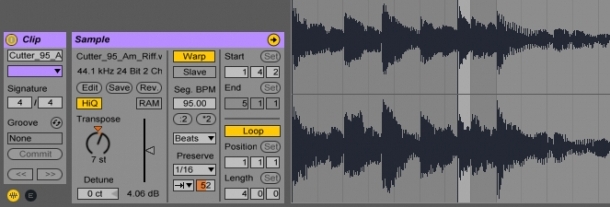
There are many crafty ways to work with loops in your productions. Besides the obvious strategies of dropping them into a project, tweaking the processing and building around them or flicking through your library to find one which fits just right, how about dropping in any old loop and mangling it into something completely new and unexpected?
In this article, I'm going to get you started on some serious tempo-synced chopping, pitching and re-sequencing of your loops to bring whole new dimensions of sound design potential to your palette. We'll cover 3 techniques, from the simple to the more involved, to get your sonic experiments and transformations off the ground - let's start squeezing some extra juice from your sample library!

Jigsaw Puzzles
When you've got a lovely, tempo-synced loop sitting neatly on your DAW's grid, you can jump straight in at the deep end with some slicing. Cutting to the grid lines means that the finished part will always keep to tempo and will probably have a coherent rhythm - or even a nice spiky groove - built right in.
One of the simplest (and one of my favourite) nifty chopping tricks is to cut the loop up into equal pieces. This can be 1/4 notes, 1/8 notes, 1/16s - it depends on how busy you want your result to be and what's actually going on in your original loop. It might be helpful to begin with bigger chunks (1/4 notes) first and then reduce the size of the segments as you experiment.
So, you've cut your loop into different segments. Next, create a new track and start moving segments down onto it, but moving them to completely different, random places within the loop. Once you've moved your segments into a new pattern and sequence, make sure they're all sitting right next to one another so there aren't any gaps or overlaps.
At this point, you may need to insert some small crossfades to avoid any clicks - very short values of around 2 to 6ms should do the trick. Now, take a listen - pretty crazy, huh' Make any tweaks you need to if anything jars but otherwise get thinking about what you could build around your chopped-up loop!
Here's an example sound, with the original loop playing first and the chopped-up, rearranged version following afterwards:

Rewrite The Score
A slightly more involved process, but giving you more control over the resulting sound, is to to chop up the loop on the notes, or transients rather than the grid points. This means going through the loop and slicing according to the waveform, unless it a synth part without any decay like a pad sound, meaning you'll need to listen for where the notes change.
As you can see in my image above, the loop I've chosen to work with has nice, clear transient points (the largest part of the waveform), so I can easily begin to slice at the right places (where the cursor is in the image).
Once you've got the main rhythm of the loop mirrored in your cuts, you can start pitch shifting the segments individually. I love to use Ableton Live for this, as you just need to go into Clip View and move the Transpose control.
Go for octave multiples (12, 24') if you like the melody in the loop, or start changing the harmonic content itself. Keeping to 5- and 7-semitone shifts means that you're a lot less likely to get bum notes, as IV and V chords will still be major or minor where the original loop is major or minor. This way, you can change the melodic shape of the little piece of music in the loop. The Dr. Rex loop player in Reason is also pretty special when you've got a REX loop to hand.
Here's my example sound, again with the original loop playing first and the re-scored and re-pitched version following:

Warp (Loop) Speed!
Here's one more simple trick you can use with a cut-up loop to transform it into something new and exciting: set up a collage of different playback speeds across the length of the loop. Whereas we used individual notes to access the melodic content with our previous technique, here we want to use groups of notes. A longer loop - 4 bars or more is best - will probably have enough space to get something unique going.
Chop the loop up into segments of 2 beats or 1 bar, say, and (in Ableton) use the Warp controls to divide the loop's built in BPM, making it play back faster in multiples of 2: twice as fast, 4 times as fast, etc. Doing this differently for each segment will automatically fill in the gaps which we would normally get from making the segment last half as long with however many copies of that same segment necessary.
Now when you play back the loop, you're going to have a cool stuttering, frantic quality with the tempo switching up in time with the rest of your project. You could also halve the volume of some of the segments two make things even more jagged. Pretty funky, eh'
Although the way I've described the execution of this final technique is Ableton Live-specific, you can achieve the same effect by bouncing out each of your sliced segments and stretching or squeezing them using simply playback speed functionality - check your DAW's native sampler and it will almost certainly feature this functionality.
Here's my final sound example:
So as you can see that whilst these are really quite basic techniques, they can be powerful ways to quickly and completely change up the feel of a loop. Give them a go and have fun experimenting with the different effects you get from using different kinds of loop material. And congratulations - you have now completed basic Loop Samurai training!













